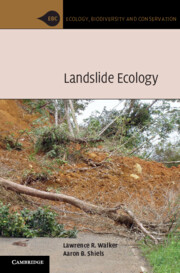4 - Biological consequences
Published online by Cambridge University Press: 05 January 2013
Summary
Key points
Landslide colonists have adaptations to survive low-nutrient, unstable substrates, where they may also experience temperature and water stress. Many of the species that colonize landslides are found exclusively in disturbed habitats and are known as gap specialists. Other colonists are common species in the adjacent undisturbed environment where their proximity to the landslide may have enabled rapid dispersal.
Microbes (including bacteria and fungi) are probably the first organisms to disperse to and colonize landslides. Symbiotic relationships, such as lichens, and plants with mycorrhizal fungi or nitrogen fixing bacteria, represent adaptations for survival in newly exposed, low-nutrient landslide substrates.
All plant life forms are found on landslides, but tend to segregate by slope. Small plants including bryophytes and forbs tend to dominate steep slopes, while tree ferns and trees tend to dominate less steep slopes. Grasses, vines, vine-like scrambling ferns, and shrubs, as well as most wind-dispersed plants, are common colonists on many landslides.
Arthropods are typically the first animals to colonize landslides, and include mites, Collembola, and ants, which are well adapted to temperature extremes and drought conditions.
Vertebrates associated with landslides are generally visitors rather than residents of the landslides. Birds and small mammals are the most common visitors, yet most vertebrates do not visit landslides until sufficient ground cover or foraging material has become established.
- Type
- Chapter
- Information
- Landslide Ecology , pp. 83 - 137Publisher: Cambridge University PressPrint publication year: 2012

